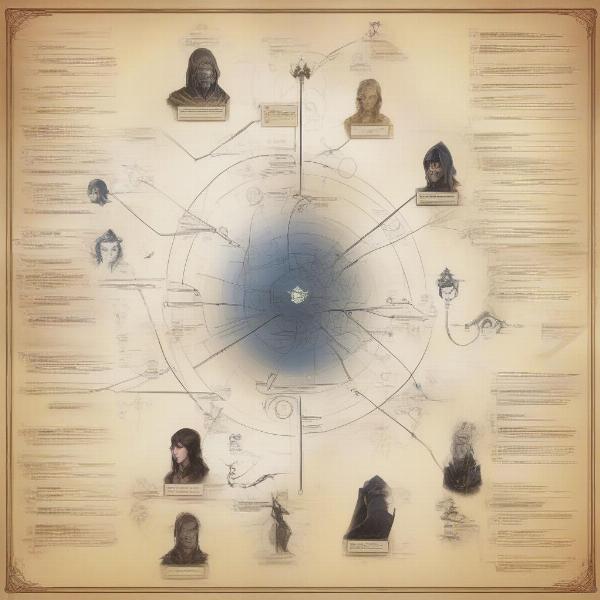The question of whether all the Souls games exist within the same universe is a complex and hotly debated topic among fans. FromSoftware, the developer of these notoriously challenging action RPGs, has never explicitly confirmed or denied a shared universe, preferring to offer cryptic hints and ambiguous connections that fuel speculation. This allows players to piece together the puzzle themselves, fostering a sense of community and shared discovery. Let’s delve into the lore, gameplay mechanics, and recurring elements that contribute to this ongoing discussion.
Are these interconnected worlds truly part of one grand narrative, or are they simply spiritual successors sharing similar DNA? The answer, much like the games themselves, isn’t straightforward. The connections are often subtle, hidden in item descriptions, environmental details, and recurring themes, rather than blatant pronouncements. The beauty of this approach lies in the freedom it gives players to interpret the evidence and draw their own conclusions.
Exploring the Connections: Lore, Items, and Characters
One of the most compelling arguments for a unified universe lies in the recurring items and themes found throughout the series. The Estus Flask, a vital healing item, appears in several Souls games, albeit with slight variations in its design and name. Similarly, the concept of hollowing, a state of despair and loss of humanity, is a recurring motif, suggesting a shared underlying cosmology. These shared elements could be interpreted as more than just Easter eggs; they could be evidence of a deeper connection.
The lore, often fragmented and obscure, also provides tantalizing hints of a larger narrative. References to ancient civilizations, powerful deities, and cyclical patterns of destruction and rebirth can be found across multiple games. While not explicitly confirming a shared timeline, these shared narratives suggest a common ancestry or a shared mythology. This allows for intriguing theories and connections to be drawn between seemingly disparate storylines.
Furthermore, recurring characters, or at least characters bearing striking resemblances to figures from previous games, add another layer to the mystery. While these could be simple homages or archetypes, their presence fuels speculation of a larger interconnected narrative. For instance, the Patches character, a mischievous merchant with a penchant for betrayal, appears in various Souls games, each iteration with slightly different motivations and circumstances. Could these be the same individual, traversing different timelines and realities?
Gameplay Mechanics and Level Design: Shared DNA
Beyond the narrative elements, the gameplay mechanics and level design also contribute to the sense of a shared universe. The core combat mechanics, the emphasis on exploration and discovery, and the interconnected level design present in many of the games create a familiar yet distinct experience. While each game has its own unique flavor, the shared DNA is undeniable.
The deliberate difficulty and the sense of accomplishment derived from overcoming challenging obstacles are hallmarks of the Souls series. This shared design philosophy further strengthens the feeling of connection between the games, fostering a sense of shared experience among players.
The intricate level design, often featuring hidden paths, shortcuts, and interconnected areas, is another common thread. This intricate design philosophy echoes the interconnectedness of the lore, further blurring the lines between separate games and suggesting a larger, more complex world.
While Bloodborne is often considered a spiritual successor rather than a direct sequel, it shares many gameplay and thematic similarities with the Dark Souls series. This begs the question: Is Bloodborne a Dark Souls game? The gameplay is strikingly similar, the themes of cosmic horror and the struggle against overwhelming odds resonate strongly with the Dark Souls universe. For more insight into this specific connection, check out our article is bloodborne a dark souls game. The similarities are striking enough to warrant further exploration.
The Miyazaki Factor: Authorial Intent and Artistic Vision
Hidetaka Miyazaki, the visionary director behind most of the Souls games, has stated that he prefers to leave the connections open to interpretation. This deliberate ambiguity allows players to engage with the lore on a deeper level, fostering a sense of community and shared discovery. Miyazaki’s artistic vision, with its focus on ambiguous narratives and interconnected themes, further contributes to the ongoing debate.
While Miyazaki’s statements suggest a degree of intentional ambiguity, the recurring elements and shared themes are too prevalent to be dismissed as mere coincidence. This intentional ambiguity allows for a richer, more engaging experience for players who enjoy piecing together the puzzle and forming their own theories.
“The beauty of ambiguity,” says Dr. Thomas Ashton, a prominent video game lore scholar, “lies in the space it creates for player interpretation. It allows individuals to connect with the narrative on a personal level, fostering a deeper sense of engagement.” This quote encapsulates the essence of Miyazaki’s approach to storytelling. By leaving room for interpretation, he empowers players to become active participants in the creation of meaning.
Are All Souls Games in the Same Universe? The Verdict
Ultimately, the question of whether all the Souls games reside in the same universe remains unanswered. While the evidence for a shared universe is compelling, the lack of explicit confirmation leaves room for debate. The beauty of this ambiguity lies in the freedom it provides players to speculate, theorize, and connect the dots themselves.
The intentional ambiguity fosters a sense of community and shared discovery. Players delve into item descriptions, analyze environmental details, and pore over dialogue snippets, piecing together the fragments of lore like archaeologists uncovering an ancient civilization. This shared pursuit of knowledge enhances the overall experience and strengthens the bonds within the Souls community.
 Connecting the Dots: Exploring the Shared Universe of Souls Games
Connecting the Dots: Exploring the Shared Universe of Souls Games
For those interested in exploring game order within specific series, our article on the recommended order to play Yakuza games offers another example of how narrative sequencing can enhance the gaming experience. You can find more information in our article what order to play yakuza games reddit. This highlights the importance of player choice and the impact of different playthrough orders.
Conclusion: Embracing the Mystery
The Souls series thrives on its mystique and ambiguity. The question of a shared universe is a testament to the richness and depth of its lore, inviting players to delve deeper and uncover the hidden connections. Whether a unified universe or a collection of spiritually connected worlds, the Souls games offer a unique and unforgettable experience. The enduring mystery is part of the magic, and the ongoing debate only adds to the richness and depth of these captivating games. So, embrace the mystery, explore the lore, and draw your own conclusions. The answer, like so many things in the Souls universe, is likely shrouded in shadows, waiting to be discovered.
FAQ
-
What are the core Souls games? The core Souls games typically include Demon’s Souls, Dark Souls 1, 2, and 3, Bloodborne, Sekiro: Shadows Die Twice, and Elden Ring.
-
Do I need to play the Souls games in order? No, each game can be enjoyed independently. However, understanding the lore and appreciating the recurring elements can be enhanced by playing them in a chronological or release order.
-
Are there any direct story connections between the Souls games? While there are recurring themes, items, and characters, the story connections are often subtle and open to interpretation.
-
Who is Hidetaka Miyazaki? Hidetaka Miyazaki is the director of most of the Souls games, known for his unique storytelling approach and challenging game design.
-
What is the significance of the Estus Flask? The Estus Flask is a recurring healing item in the Souls series, often seen as a symbolic connection between the games.
-
What is hollowing? Hollowing is a recurring concept in the Souls series, representing a state of despair and loss of humanity.
-
Why is the shared universe theory so popular among Souls fans? The ambiguity and recurring elements encourage speculation and create a sense of shared discovery within the community.

